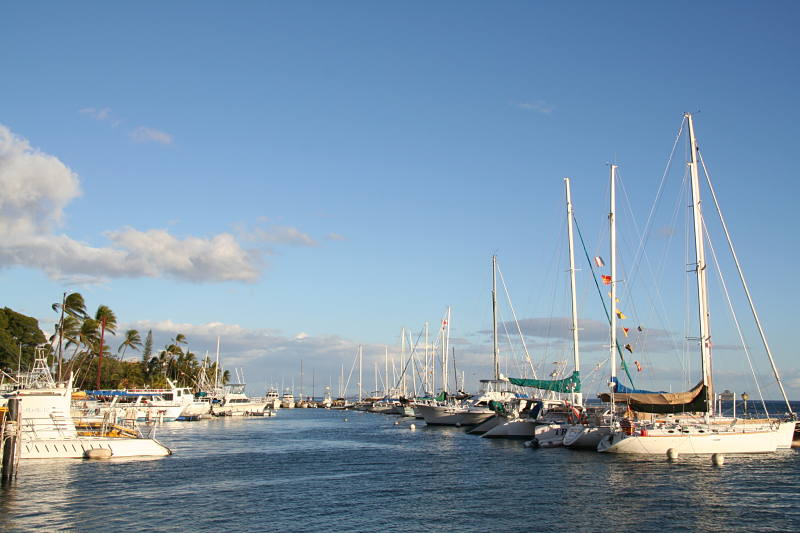10 Reasons We're Thankful to Live on Maui
This list could've run on for pages and pages. But on this extended holiday weekend, we'll settle for our top 10 reasons to be thankful for living on ...

As you may or may not know, our Maui ocean tours operate out of Lahaina Harbor, just a block from Front Street with all its shops, restaurants, and art galleries. Then there are the museums, and many historic sites that you might walk past without even noticing. But if you look closely and take the time to wonder at its past, you'll make some interesting discoveries. Lahaina is an interesting place to visit, and to work, especially considering the many dramatic phases of its history.
It's common knowledge among residents that Lahaina was once the capital city of Hawaii, having been conquered by King Kamehameha the great in 1795. Lahaina means "cruel sun" in the Hawaiian language, reflecting the heat and low rainfall of the area. It gets less than 13 inches of rain a year. In a fateful decision by Kamehameha III in 1845, the capital city was moved to Honolulu. We can only imagine what Lahaina would look like today, had that change never been made. Envisioning Lahaina as a bustling metropolis would be grim for most of us. For a number of reasons, however, Lahaina was the busiest port in Hawaii for many years in the 1800's.
In that century, whale fat was rendered into oil that fueled lamps. Hawaii's whale population was exploited for that purpose. Today, the waters off Maui's south and western shores are where migrating humpbacks are found in their greatest number. Assuming this was equally true in the days of whaling, Lahaina was in a perfect position for whalers to take advantage, although they tended to focus their hunting on sperm whales, which can also be found in Hawaiian waters. With the robust whale population in its surrounding waters, Lahaina came to be considered the whaling capital of the world. Thankfully, the practice has long since been banned, and humpbacks continue to return to their winter breeding grounds every year, arriving as early as October and leaving as late as May. Now, the Lahaina Harbor is home to charters like ours that have the privilege of taking guests out on Maui whale watching tours.
During the whaling years, sailors commonly came into conflict with the Christian missionaries who had established themselves in Lahaina. At one point, a whaleship even opened fire on the town because of these conflicts. In response to the violence, including several riots, the Royal Governor of Maui, Hoapili, initiated the construction of the Old Lahaina Fort in 1831. Just months before her death, Queen Kaʻahumanu came to support its construction with her influence, and the fort was completed within a month. It boasted 20-foot walls and 47 cannons. It was demolished in 1854, and replaced by a courthouse, which remains to this day, maintained by the Lahaina Arts Council and the Lahaina Historic Society. Although the fort was demolished, a portion of it was reconstructed in 1964. You'll find it across the street from the current Lahaina Harbor.
Another one of Lahaina's historic features that remains today is the Lahaina Lighthouse, although it has been modified and updated over the years. It was originally commissioned by Kamehameha III, the same king who moved the capital of Hawaii to Honolulu, if you'll remember. The lighthouse was built in 1840, standing at just 9 feet tall, and was first lit on November 4th with a lamp fed by the same whale oil harvested off its shore. Its date of construction made it the first navigation aid in Hawaii, and the first lighthouse in the whole US Pacific. By 1866, its height was increased to 26 feet, and its fuel changed to kerosene. When Hawaii was annexed by the US, the lighthouse was reconstructed at 55 feet tall and outfitted with a fresnel lens in 1905. By 1937, it had switched to electric power. Today, it is maintained by the Lahaina Restoration Foundation.
The lighthouse, the courthouse, and the restored portion of the fort are all visible from Lahaina Harbor. If you book one of our Maui ocean activities, you'll likely spot them when you arrive. Seeing historic sites like these can make a trip to Maui even more memorable, especially if you enjoy learning about history. Mahalo!
This list could've run on for pages and pages. But on this extended holiday weekend, we'll settle for our top 10 reasons to be thankful for living on ...
1.) At just over 140 square miles, Lana'i is the sixth largest island of the Hawaiian island chain. During the 2010 census, Lana'i's counted just 3,10...
Unlike the Caribbean, there hasn't been a long history of pirate activity in Hawaii. But there is one incident, one that many believe was the last lar...
